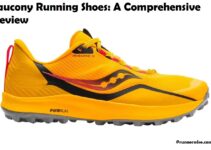Are you a runner plagued by shin splints? You don’t have to suffer in silence any longer!
With the right running shoes, you can reduce and even prevent this agonizing condition. Keep reading to learn how to find the perfect fit for you and conquer your next run without worry.
Shin splints is one of the most common injuries among runners, but luckily, they can be prevented with the right running shoe. In this guide, we’ll help you find the perfect shoe that will provide enough cushion and comfort while still preserving the natural dynamics of your foot’s movement.
We’ll discuss what causes shin splints, how to choose the right shoe and which running shoes are recommended for preventing shin splints. We’ll also cover overpronation and what it means to be “over- pronated” when running. By understanding all these elements, you can avoid a painful future full of shin splints.
Explanation of shin splints
Shin splints is a common injury endured by runners due to continuous and repetitive pounding on the shin bone (tibia) over a period of time. The injury is caused by the muscle, tendons and bone tissue in the shin area being too strong for the soft tissue such as ligaments in between them, resulting in micro tears and inflammation. Shin splints may occur gradually or due to an abrupt increase in intensity or duration of running. Symptoms include tenderness, swelling and pain along the front or inside part of the lower legs which can become worse when pressure is applied.
The best way to prevent shin splints from developing is to invest in a pair of running shoes specifically designed for your foot type, activity level, surface type and personal goals. When it comes to structural features of your running shoes, be sure they provide enough support padded outsole unit with superior cushioning system since that can absorb shock better before it reaches the athletes leg muscles. Good running shoes should also provide plenty arch support, helping protect your feet against overpronation and supination while also offering stability when you’re heel striking with more force.
Importance of proper running shoes to prevent shin splints
The prevention of shin splints begins with the selection of a properly fitting athletic shoe that has the appropriate cushioning, support and flexibility needed for your activity. When buying running shoes, it is important to note that not all running shoes are created equal. Each shoe features unique features and design elements to fit different types of feet, running surfaces and impact levels.
It is essential for any runner to understand their particular foot mechanics in order to choose the best shoe type and size for their needs. An incorrectly fitting or worn out shoe can increase stress on the hips, legs, feet, and ultimately lead to an increased risk of shin splints.
Choosing a proper running shoe starts by assessing your foot type – flat feet or high arches – as well as wearing appropriate socks that match the running surface – cinder track vs asphalt road. Once you know what type of foot you have and what kind of surface you are going to run on most often, it’s time to find a pair that meet these criteria while providing sufficient cushioning and support along with excellent breathability.
Along with finding the right fitting runners for your needs, proper breaking-in strategies are important when transitioning over from old shoes too new ones in order ensure they do not cause any additional strain or pressure on your lower legs during workouts or race day preparation. If shin splits persist despite taking cautionary measures in picking the right footwear; seeking early treatment from a Physiotherapist may be beneficial for preventing pain reoccurrence during future runs.
Understanding Shin Splints
Shin splints is a general term used to describe pain in the lower leg caused by running or jumping. The most common cause of shin splints is over-stressing the tibia (shinbone) and its related muscles. This can be due to excessive running distances or running on hard surfaces, as well as the type of footwear worn by a runner.
Typically symptoms of shin splints include pain, tenderness, and sometimes swelling along the front edge of the tibia. It’s important to distinguish shin splints from stress fractures — which require more intensive medical treatment — because both conditions have similar symptoms. Treatment for shin splints can often consist of rest and ice, along with wearing appropriate footwear for running.
Although there are a variety of treatments available for shin splints, you may wish to start by ensuring the right footwear is being worn when running or taking part in another repetitive impact sport such as basketball or tennis. Choosing well-made shoes that fit properly can help protect against potential injuries like shin splints and provide extra cushioning and stability when on your feet. We will dive into this deeper below in order to understand what makes shoes well-suited for Shin Splint protection.
Definition of shin splints
Shin splints are a common, overuse injury among runners, which frequently presents as pain in lower extremities- usually radiating from the front and sides of the ankles or shins. Shin splints occur when muscles and tendons around your tibia become inflamed due to excessive pushing off during running on hard surfaces. The main cause of shin splints is a sudden increase in activity or intensity that overwhelms your body’s current abilities. Individuals with flat arches, those who run mostly on hard surfaces, and those with bowling leg are more prone to developing this condition.
In addition to being painful, shin splints can severely limit knee mobility and force you to cut short runs. Fortunately, there are several ways to reduce the risk of developing shin splints by wearing some lightweight supportive shoes that are designed especially for runners. The right shoes will help cushion impacts and provide extra support for vulnerable feet so that you can focus on running without pain.
Causes of shin splints
Shin splints, also known as tibial stress syndrome (TSS), are most commonly caused by repetitive activities like running. This repetitive motion can cause micro-tears in the muscles and tendons that attach to the shinbone (tibia). The tears cause pain and swelling in the soft tissues of the shin resulting from over-exertion or improper training methods.
Another major cause for shin splints is the lack of adequate cushioning on the feet caused by inappropriate shoe selection. The majority of running shoes provide cushioning, but an individual’s foot shape, size and gait determine how much support a particular shoe provides. If your feet are not adequately supported when running, it can result in increased pressure being placed on your shins which can lead to pain and injury. Additionally, improper arch support can contribute to shin splints as well. Flat arches require more arch support than higher arches do and an improperly fitting or shoes that lack adequate arch support may exacerbate the condition further.
Other factors to consider when looking at possible causes of shin splints include uphill running, which puts additional strain on the muscles of the lower legs; wearing a shoe with flexible soles; uneven surfaces; inadequate rest/recovery times between exercise sessions; rapid changes in workout intensity; overly tight calf muscles (a sign you’re over-working them); poor foot placement while walking/running; weak abdominal or hip muscles, or even osteoporosis (which weakens bones). No matter what causes your shin splint symptoms, finding out why is key if you want to prevent them from reoccurring in the future.
Symptoms of shin splints
The most common symptom of shin splints is an aching or burning pain along the front, inner or outer part of the shin. You may also experience tenderness in the area, especially if you press on it. You may find that swelling, redness and heat are localized to your shins after workouts as well. In some cases, people also report feeling numbness or tingling in their shins.
Shin splints can also cause pain and difficulty while running or even during everyday activities like walking up stairs. If left untreated, more severe shin problems may develop, such as stress fractures and even permanent damage to muscle tendons and bones.
It’s important to know when to seek medical attention if the symptoms persist for more than a few days or worsen with activity.
How Running Shoes Prevent Shin Splints
Running shoes are designed to provide stability, prevent injury, and keep you running in comfort. In order to reduce the chance of getting shin splints, the right pair of running shoes is essential.
When choosing a running shoe, it is important to look for a few key features. First, look for a shoe with cushioning and shock absorbency that reduces the impact on your feet, ankles, and shins. Make sure the shoe has an appropriate midsole for stability as well as arch support when needed. Choose a running shoe with good flexibility which provides more natural movement and works in harmony with your own stride pattern. Lastly, pay attention to size. Make sure the heel of your running shoe fits comfortably and that it doesn’t slip off when you run or walk; likewise, make sure the toe box is not too cramped so your toes don’t feel squished.
With proper fitting footwear and supportive orthotics if needed, you can minimize stress on your shins while running or jogging and decrease the chances of developing shin splints or exacerbating existing ones.
Features of running shoes that prevent shin splints
Shin splints can be both a painful and debilitating condition, but there are several precautions and treatments that can help prevent it. One of the most important steps to prevent shin splints is to select the right running shoes. Different types of running shoes provide added cushioning, foot support, and flexibility in order to protect the delicate structures in your shins from injuries. Here are some features of running shoes that can help you avoid shin splints:
- Cushioning: Running shoes should have some cushioning so that your foot is not exposed to too much pressure when making contact with the ground. Look for high-quality cushioning that provides enough shock absorption during impact, but also remains lightweight for easy movement.
- Arch Support: Adequate arch support is important in preventing shin splints as well since it helps evenly disperse pressure across the sole of your foot when you run. This means that too much pressure is not concentrated on one part of your foot muscles, which will reduce the stress on your muscles when moving around.
- Flexibility: It’s also important to look for running shoes with adequate flexibility in order to avoid any painful tightness or restriction while running. This will ensure that your feet are able to move naturally while they take different strides, allowing them to better absorb impact and reduce stress on your shins’ muscle groups when running longer distances or periods at faster speeds. Highly flexible textiles used in shoe construction can provide improved shock-absorption without adding extra weight or bulkiness to each shoe.
By ensuring you choose running shoes that provide all these features mentioned above, you’ll be able to reduce the risk of developing shin splints due to overuse injuries or improper footwear selection and design.
Importance of proper fit
Getting the right fit for your running shoes is absolutely essential when it comes to preventing shin splints. A proper fit should allow your feet to have space to move around and expand, yet still easily manage to form a snug and secure fit on your foot. Once you find the right size and width, it is important that you try on running shoes while wearing the same type of socks that you would normally use for running. This will give you a much more accurate sizing and ensure that the shoes are comfortable when wearing them during your workout session.
Furthermore, regardless of how comfortable running shoes might feel when standing up or walking around in, this feeling does not necessarily carry over when you are running. It’s important to make sure that your shoes provide enough cushioning during these activities because this support can help minimize wear patterns on the soles of the shoe, thus helping keep them durable for longer durations of time. Additionally, proper cushioning helps absorb any shock that may otherwise cause damaging injuries such as shin splints.
Ultimately, making sure that you have adequate support and cushioning with properly fitted running shoes is integral when trying to reduce your risk of developing shin splints or other related injuries.
Types of running shoes that are best for preventing shin splints
There are two types of running shoes that can help prevent shin splints: stability and cushioning running shoes. Stability shoes are best for those who pronate heavily (excessive foot rotation inward) when running, as they control excessive pronation with density materials placed in the midsole. Cushioning shoes are ideal for those who have normal or neutral pronation, as they combine cushioning technology with a flexible midsole designed to absorb shock better while providing energy return.
When selecting a running shoe to help prevent shin splints, there are many options available. It can be helpful to consult a specialty running store if you need guidance on choosing the right shoe for you and your feet. When selecting a shoe, it is important to consider the type of terrain you will be running on, your arch type (high or low), weight and function needed — such as speed or stability — among other elements. Many brands also have orthotic styles that provide enhanced motion control if needed due to abnormally shaped feet or unique issues such as collapsing arches.
Lastly, it’s important to note that some factors should be considered when considering long-term use of any specific running shoe — such as cushioning support system used, upper materials/support structures and sole/outsole configuration used––to ensure proper use and comfort over time.
Conclusion
In conclusion, finding the right running shoe for your needs is an important step in preventing shin splints. Running shoes should be selected based on the width of your feet, pronation type, gait cycle and heel-to-toe ratio. It is also important to consider how much cushioning and stability are needed and desired for your run. All of these considerations will help ensure that you get the most enjoyment out of running without the risk of shin splints.
Additionally, knowing when to replace running shoes and maintaining a varied exercise program that includes strength training will add extra layers of protection to prevent injury. By following these guidelines, you can rest assured that you’ll be able to stay active and healthy while enjoying all the benefits of running with minimal risk of shin splints.
FAQ’s
Do good running shoes prevent shin splints?
Good running shoes can help prevent shin splints by providing proper support and cushioning to the feet and reducing impact on the shins.
What shoes are best for shin splints while running?
Shoes with good cushioning, support, and stability are generally the best option for people with shin splints while running. It is recommended to consult with a podiatrist or shoe expert for personalized recommendations.
Can certain running shoes cause shin splints?
Yes, certain running shoes that are too worn out, provide inadequate support, or do not fit properly can cause shin splints.
What to look for in running shoes to prevent shin splints?
When looking for running shoes to prevent shin splints, one should look for shoes that offer good cushioning, support, stability, and fit properly.
How do athletes avoid shin splints?
Athletes can avoid shin splints by gradually increasing training intensity, wearing proper shoes, using good form while running, and engaging in strength and flexibility exercises.
Is more cushioning better for shin splints?
While more cushioning may help reduce impact on the shins, it is not always necessary and may depend on individual preferences and running style. A podiatrist or shoe expert can provide personalized recommendations.
What worsens shin splints?
Wearing worn-out or unsupportive shoes, running on hard surfaces, increasing training intensity too quickly, and having poor running form can worsen shin splints.
Why do I always get shin splints when running?
Shin splints can be caused by a variety of factors, including overuse, improper footwear, weak muscles, and poor running form.
Do compression socks stop shin splints?
Compression socks may help alleviate symptoms of shin splints, but they are not a guaranteed cure. It is recommended to consult with a podiatrist or doctor for personalized recommendations.
What is the fastest way to heal shin splints?
The fastest way to heal shin splints is to rest and allow the affected area to heal, apply ice and take anti-inflammatory medication to reduce pain and swelling, and engage in strengthening and flexibility exercises to prevent future injuries.
See Also-
- Best running shoes for long distance
- Best lightweight running shoes
- Best running shoes for narrow feet
- Best long distance running shoes
- Best running shoes for shin splints


